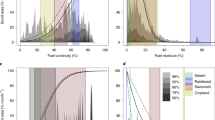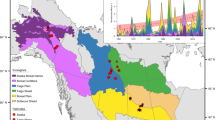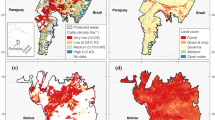Abstract
Wildfires are common in boreal forests around the globe and strongly influence ecosystem processes. However, North American forests support more high-intensity crown fires than Eurasia, where lower-intensity surface fires are common. These two types of fire can result in different net effects on climate as a consequence of their contrasting impacts on terrestrial albedo and carbon stocks. Here we use remote-sensing imagery, climate reanalysis data and forest inventories to evaluate differences in boreal fire dynamics between North America and Eurasia and their key drivers. Eurasian fires were less intense, destroyed less live vegetation, killed fewer trees and generated a smaller negative shortwave forcing. As fire weather conditions were similar across continents, we suggest that different fire dynamics between the two continents resulted from their dominant tree species. In particular, species that have evolved to spread and be consumed by crown fires as part of their life cycle dominate North American boreal forests. In contrast, tree species that have evolved to resist and suppress crown fires dominate Eurasian boreal forests. We conclude that species-level traits must be considered in global evaluations of the effects of fire on emissions and climate.
This is a preview of subscription content, access via your institution
Access options
Subscribe to this journal
Receive 12 print issues and online access
$259.00 per year
only $21.58 per issue
Buy this article
- Purchase on Springer Link
- Instant access to full article PDF
Prices may be subject to local taxes which are calculated during checkout




Similar content being viewed by others
References
Ryan, K. C. Dynamic interactions between forest structure and fire behavior in boreal ecosystems. Silva Fenn. 36, 13–39 (2002).
Wirth, C. in Forest Diversity and Function (eds Scherer-Lorenzen, D. M., Körner, P. D. C. & Schulze, P. D. E-D.) 309–344 (Springer, 2005).
Flanner, M. G., Zender, C. S., Randerson, J. T. & Rasch, P. J. Present-day climate forcing and response from black carbon in snow. J. Geophys. Res. 112, D11202 (2007).
Amiro, B. D. et al. The effect of post-fire stand age on the boreal forest energy balance. Agric. For. Meteorol. 140, 41–50 (2006).
Randerson, J. T. et al. The impact of boreal forest fire on climate warming. Science 314, 1130–1132 (2006).
Rogers, B. M., Randerson, J. T. & Bonan, G. B. High-latitude cooling associated with landscape changes from North American boreal forest fires. Biogeosciences 10, 699–718 (2013).
Korovin, G. N. in Fire in Ecosystems of Boreal Eurasia (eds Goldammer, J. G. & Furyaev, V. V.) 112–128 (Springer, 1996).
Shvidenko, A. Z. & Nilsson, S. in Fire, Climate Change, and Carbon Cycling in the Boreal Forest (eds Kasischke, E. S. & Stocks, B. J.) 132–150 (Springer, 2000).
Furyaev, V. V., Vaganov, E. A., Tchebakova, N. M. & Valendik, E. N. Effects of fire and climate on successions and structural changes in the Siberian boreal forest. Eurasian J. For. Res. 2, 1–15 (2001).
Wooster, M. J. & Zhang, Y. H. Boreal forest fires burn less intensely in Russia than in North America. Geophys. Res. Lett. 31, L20505 (2004).
McRae, D. J. et al. Variability of fire behavior, fire effects, and emissions in Scotch pine forests of central Siberia. Mitig. Adapt. Strateg. Glob. Change 11, 45–74 (2006).
De Groot, W. J. et al. A comparison of Canadian and Russian boreal forest fire regimes. For. Ecol. Manage. 294, 23–34 (2013).
Agee, J. K. in Ecology and Biogeography of Pinus (ed. Richardson, D. M.) 193–218 (Univ. Cambridge, 1998).
Mutch, R. W. Wildland fires and ecosystems—A hypothesis. Ecology 51, 1046–1051 (1970).
Rowe, J. S. in The Role of Fire in Northern Circumpolar Ecosystems (eds Wein, R. W. & Maclean, D. A.) 135–154 (John Wiley, 1983).
Dyrness, C. & Norum, R. The effects of experimental fires on black spruce forest floors in interior Alaska. Can. J. For. Res. 13, 879–893 (1983).
Viereck, L. A. & Johnston, W. F. in Silvics of North America Vol. 1 (eds Burns, R. M. & Honkala, B. H.) 227–237 (US Forest Service, 1990).
Wein, R. W. & MacLean, D. A. in The Role of Fire in Northern Circumpolar Ecosystems (eds Wein, R. W. & MacLean, D. A.) 1–18 (Wiley, 1983).
Nikolov, N. & Helmisaari, H. in A Systems Analysis of the Global Boreal Forest (eds Shugart, H. H., Leemans, R. & Bonan, G. B.) 13–84 (Cambridge Univ. Press, 1992).
Richardson, D. M. & Rundel, P. W. in Ecology and Biogeography of Pinus (ed. Richardson, D. M.) 3–46 (Univ. of Cambridge, 1998).
Furyaev, V. V., Wein, R. W. & MacLean, D. A. in The Role of Fire in Northern Circumpolar Ecosystems Vol. 18 (eds Wein, R. W. & MacLean, D. A.) 221–234 (Wiley, 1983).
Dyrness, C. T., Viereck, L. A. & Van Cleve, K. in Forest Ecosystems in the Alaskan Taiga (eds Van Cleve, K., Chapin, F. S. III, Flanagan, P. W., Viereck, L. A. & Dyrness, C. T.) 74–86 (Springer, 1986).
Furyaev, V. V. in Fire in Ecosystems of Boreal Eurasia (eds Goldammer, J. G. & Furyaev, V. V.) 168–185 (Springer, 1996).
Goetz, S. J., Mack, M. C., Gurney, K. R., Randerson, J. T. & Houghton, R. A. Ecosystem responses to recent climate change and fire disturbance at northern high latitudes: Observations and model results contrasting northern Eurasia and North America. Environ. Res. Lett. 2, 045031 (2007).
Johnstone, J. F. et al. Fire, climate change, and forest resilience in interior Alaska. Can. J. For. Res. 40, 1302–1312 (2010).
Flannigan, M., Stocks, B., Turetsky, M. & Wotton, M. Impacts of climate change on fire activity and fire management in the circumboreal forest. Glob. Change Biol. 15, 549–560 (2009).
Tchebakova, N. M., Parfenova, E. & Soja, A. J. The effects of climate, permafrost and fire on vegetation change in Siberia in a changing climate. Environ. Res. Lett. 4, 045013 (2009).
Kasischke, E. S., Christensen, N. L. & Stocks, B. J. Fire, global warming, and the carbon balance of boreal forests. Ecol. Appl. 5, 437–451 (1995).
Soja, A. J. et al. Climate-induced boreal forest change: Predictions versus current observations. Glob. Planet. Change 56, 274–296 (2007).
Osawa, A. & Matsuura, Y. Permafrost Ecosystems: Siberian Larch Forests (Springer, 2010).
Valendik, E. N. in Fire in Ecosystems of Boreal Eurasia (eds Goldammer, J. G. & Furyaev, V. V.) 129–138 (Springer, 1996).
Smith, A. M. S. & Wooster, M. J. Remote classification of head and backfire types from MODIS fire radiative power and smoke plume observations. Int. J. Wildland Fire 14, 249–254 (2005).
Alexander, M. E. & Cruz, M. G. Interdependencies between flame length and fireline intensity in predicting crown fire initiation and crown scorch height. Int. J. Wildland Fire 21, 95–113 (2012).
Giglio, L., Csiszar, I. & Justice, C. O. Global distribution and seasonality of active fires as observed with the Terra and Aqua Moderate Resolution Imaging Spectroradiometer (MODIS) sensors. J. Geophys. Res. 111, G02016 (2006).
Jin, Y. et al. The influence of burn severity on postfire vegetation recovery and albedo change during early succession in North American boreal forests. J. Geophys. Res. 117, G01036 (2012).
Hely, C., Flannigan, M. & Bergeron, Y. Modeling tree mortality following wildfire in the southeastern Canadian mixed-wood boreal forest. For. Sci. 49, 566–576 (2003).
Dixon, R. K. & Krankina, O. N. Forest fires in Russia: Carbon dioxide emissions to the atmosphere. Can. J. For. Res. 23, 700–705 (1993).
Lavoue, D., Liousse, C., Cachier, H., Stocks, B. J. & Goldammer, J. G. Modeling of carbonaceous particles emitted by boreal and temperate wildfires at northern latitudes. J. Geophys. Res. 105, 26871–26890 (2000).
Giglio, L., Loboda, T., Roy, D. P., Quayle, B. & Justice, C. O. An active-fire based burned area mapping algorithm for the MODIS sensor. Remote Sens. Environ. 113, 408–420 (2009).
Van der Werf, G. R. et al. Global fire emissions and the contribution of deforestation, savanna, forest, agricultural, and peat fires (1997–2009). Atmos. Chem. Phys. 10, 11707–11735 (2010).
Oleson, K. W. et al. Technical Description of version 4.5 of the Community Land Model (CLM) (NCAR Earth System Laboratory, Climate and Global Dynamics Division, 2013).
Michaletz, S. T., Johnson, E. A., Mell, W. E. & Greene, D. F. Timing of fire relative to seed development may enable non-serotinous species to recolonize from the aerial seed banks of fire-killed trees. Biogeosciences 10, 5061–5078 (2013).
Gower, S. T. & Richards, J. H. Larches: Deciduous conifers in an evergreen world. Bioscience 40, 818–826 (1990).
Bergeron, Y., Flannigan, M., Gauthier, S., Leduc, A. & Lefort, P. Past, current and future fire frequency in the Canadian boreal forest: Implications for sustainable forest management. Ambio 33, 356–360 (2004).
Rupp, T. S., Starfield, A. M., Chapin, F. S. & Duffy, P. Modeling the impact of black spruce on the fire regime of Alaskan boreal forest. Climatic Change 55, 213–233 (2002).
Davis, M. B. in Forest Succession: Concepts and Applications (eds West, D. C., Shugart, H. H. & Botkin, D. B.) 132–153 (Springer, 1981).
Lloyd, A. H. et al. in Alaska’s Changing Boreal Forest (eds Chapin, F. S. III, Oswood, M. W., Van Cleve, K., Viereck, L. A. & Verbyla, D. L.) 62–80 (Oxford Univ. Press, 2006).
Girardin, M. P. et al. Vegetation limits the impact of a warm climate on boreal wildfires. New Phytol. 199, 1001–1011 (2013).
Turetsky, M. R., Amiro, B. D., Bosch, E. & Bhatti, J. S. Historical burn area in western Canadian peatlands and its relationship to fire weather indices. Glob. Biogeochem. Cycles 18, GB4014 (2004).
Staver, A. C., Archibald, S. & Levin, S. A. The global extent and determinants of savanna and forest as alternative biome states. Science 334, 230–232 (2011).
Acknowledgements
This work was financially supported by the US National Science Foundation (NSF) and the National Aeronautics and Space Administration (NASA). NSF support included a Graduate Research Fellowship (ID 2009067341) to B.M.R. and a Decadal and Regional Climate Prediction using Earth System Models award to J.T.R. (AGS-1048890). This work was also supported by NASA Carbon Cycle (NNX11AF96G), Atmosphere (NNX10AT83G), and Interdisciplinary Research in Earth Science (NNH09ZDA-IDS-0116) programs, and the Carbon in Arctic Reservoirs Vulnerability Experiment (CARVE). We thank S. Conard, W. Kurz, S. Goetz and S. Davis for conversations on continental fire patterns, the National Research Council Canada for providing mapped forest inventory data, and the NASA LP DAAC for data distribution.
Author information
Authors and Affiliations
Contributions
B.M.R., J.T.R., M.L.G. and A.J.S. designed research; B.M.R. performed the research; A.J.S. provided Russian vegetation data sets; B.M.R. drafted the paper; J.T.R., M.L.G. and A.J.S. contributed to the interpretation of the results and to the text.
Corresponding author
Ethics declarations
Competing interests
The authors declare no competing financial interests.
Supplementary information
Supplementary Information
Supplementary Information (PDF 4500 kb)
Rights and permissions
About this article
Cite this article
Rogers, B., Soja, A., Goulden, M. et al. Influence of tree species on continental differences in boreal fires and climate feedbacks. Nature Geosci 8, 228–234 (2015). https://doi.org/10.1038/ngeo2352
Received:
Accepted:
Published:
Issue Date:
DOI: https://doi.org/10.1038/ngeo2352
This article is cited by
-
Simulating long-term wildfire impacts on boreal forest structure in Central Yakutia, Siberia, since the Last Glacial Maximum
Fire Ecology (2024)
-
Millennial-aged pyrogenic carbon in high-latitude mineral soils
Communications Earth & Environment (2024)
-
Simulating dynamic fire regime and vegetation change in a warming Siberia
Fire Ecology (2023)
-
Forest composition change and biophysical climate feedbacks across boreal North America
Nature Climate Change (2023)
-
Asymmetric influence of forest cover gain and loss on land surface temperature
Nature Climate Change (2023)



